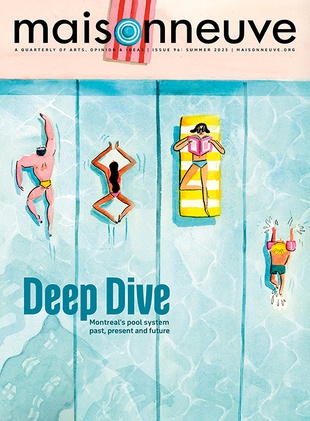Old Hats (and New) at the National Ballet of Canada
A look at the company's artistic shake-up.
On May 18, just days after my trip to Toronto to catch An Italian Straw Hat, the National Ballet of Canada’s latest offering from James Kudelka, startling news came via e-mail. After nine years at the helm of the largest and most critically acclaimed ballet company in Canada, Kudelka announced he was stepping down as artistic director to assume the position of resident choreographer.
The reaction amid the Toronto press and on my favourite ballet chat board was shock. Nonetheless, like some, I see this as a positive development. In a press release, Kudelka stated he wanted more time for creation—a decision I feel should be cheered when considering such masterful works as his productions of The Four Seasons and Cinderella. Further, given the National’s move in 2006 to the Four Seasons Centre for the Performing Arts, currently under construction, now would seem as good a time as any to make a transition in artistic directorship.
This news topped off what has been an eventful spring for the company. For the first time in seven years, the National played New York, bringing Kudelka’s original 2002 ballet The Contract to the Brooklyn Academy of Music (BAM). Unfortunately, the ballet earned lacklustre reviews. (I have not seen the ballet but one critic, whose opinion I respect, told me that New York got it wrong, that the work is a real keeper and years hence will garner its proper due.)
However disappointing New York proved, this spring brought some good news: both American Ballet Theatre and Boston Ballet are slated to produce Kudelka’s Cinderella, a critical hit when it premiered last year. With its snatches of humour, it was, as it turned out, a warm-up for the choreographer’s latest, An Italian Straw Hat.
Throughout his career, Kudelka has become known as a choreographer drawn more to the darker terrain of human experience than the lighter side of life. As such, his first attempt at full-length comedic ballet was not to be missed. Based on a nineteenth-century French farce by Eugène Labiche and Marc Michel, An Italian Straw Hat is a sexy romp that is less wink-wink, nudge-nudge and more outrageously bawdy fun.
The story goes something like this: Ferdinand, a young man about Paris, is to be married to the sweetly demure Hélène. Unfortunately, while our groom-to-be is in a park, his horse eats the Italian straw hat of Anaïs, who is in the midst of an illicit tryst with her lover Emil. The two adulterous lovers demand that Ferdinand replace the hat, as otherwise Anaïs’s husband Beaujolais will guess her infidelity. If Ferdinand does not accomplish this task, the lovers warn they will thwart his marriage. Ferdinand, aided by his servant Felix and Anaïs’s maid Virginia, scours Paris for a replacement hat amid a tangle of wedding guests and police. But all ends well with Anaïs’s reputation saved, and Ferdinand and Hélène happily wed.
As we follow Ferdinand through Paris, we also meet the Baroness (Anaïs’s aunt), Clara (jilted at the alter by Ferdinand), Nisnardi (a violin virtuoso), scads of society ladies and gentlemen and Hélène’s provincial family.
It was no wonder Ferdinand looked a little befuddled—I could empathize. Even though I saw two performances, keeping everyone straight in the midst of plot complications and mistaken identities was difficult, and frankly, without a libretto I am not sure I would have understood all of the happenings onstage. As a result, two questions occurred to me: Was the problem that, plot-wise, An Italian Straw Hat is too unwieldy for a ballet? Or was this evidence that Kudelka, in his first foray into full-evening comedy, had needed to spend more time retooling?
If the overarching story proved to be overwhelming, at least Kudelka succeeded in the individual comedic moments, like the Keystone Cops routine of the gendarme brigade with its bumbling, overweight chief of police.
If the overarching story proved to be overwhelming, at least Kudelka succeeded in the individual comedic moments, like the Keystone Cops routine of the gendarme brigade with its bumbling, overweight chief of police. My favourite parts, though, were the parodies of the pas de deux. Kudelka provided the libidinous servants, Felix and Virginia, with plenty of unabashed humping and transformed the flexibility of ballet bodies and positions into indecent gymnastics. For the duets involving the illicit lovers, Anaïs and Emil, absurd aerial cartwheels replaced the traditional ecstatic lifts of ballerina by her lover. And in Beaujolais’s duet with Virginia, the decrepit husband partnered with one foot in a bucket.
Oddly, because Kudelka is such a master of this duet, it was the straight pas de deux that suffered with this performance. In particular, the pas between the two protagonists, Ferdinand and Hélène; both occur too late in the performance and fail to show off the chemistry between the lovers. Granted farce demands a fast pace, which Kudelka delivers, but the audience is never led to understand why Ferdinand is so keen to marry Hélène—he is, after all, a former ladies’ man, as Kudelka shows. The final scene is of the newly married couple flying in a balloon across the sky. As in all great comedies, it is this twosome, not the sex-crazed servants or adulterous lovers, with whom we want to share in the happiness and hope of having overcome so many obstacles. Instead, the grand moment is left a little flat.
It’s a real shame, too, that Hélène gets few chances to shine before the end, especially when radiant Heather Ogden dances the part. Other standouts included Xiao Nan Yu, who brought out the complexity in the slight role of Clara; both casts of Virginia and Felix (Piotr Stanczyk and Rebekah Rimsay, and Richard Landry and Stacey Shiori Minagawa); Victoria Bertram who, in drag, played three characters; and Jean-Sébastien Colau as the Baroness, whose pointe work could put the Trocks to shame.
With so many good performances by the company’s dancers, and thanks to the opportunities Kudelka provides, let’s hope that whoever next wears the artistic director’s hat will revive Kudelka’s balletic farce and iron out the kinks. As Canada’s most celebrated ballet choreographer (and one of the world’s best still working within the classical style), Kudelka, at the age of forty-nine, has many years ahead of him. Let’s hope he continues to move and delight his audiences.
Kena Herod is the dance critic for Maisonneuve Magazine. The Dance Scene appears every other Tuesday.





